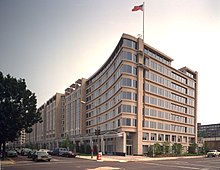
Back Nasa Afrikaans NASA ALS ናሳ Amharic NASA AN NASA ANG ناسا Arabic ناسا ARY ناسا ARZ নাছা Assamese NASA AST
 NASA seal | |
 | |
 Mary W. Jackson NASA Headquarters building in Washington, D.C. | |
| Agency overview | |
|---|---|
| Abbreviation | NASA |
| Formed | July 29, 1958 |
| Preceding agency |
|
| Type | Space agency Aeronautics research agency |
| Jurisdiction | United States Federal Government |
| Headquarters | Mary W. Jackson NASA Headquarters Washington, D.C. 38°52′59″N 77°0′59″W / 38.88306°N 77.01639°W |
| Bill Nelson | |
| Deputy Administrator | Pamela Melroy |
| Primary spaceports | |
| Employees | 17,960 (2022)[2] |
| Annual budget | |
| Website | nasa |
| Part of a series on the |
| United States space program |
|---|
  |
The National Aeronautics and Space Administration (NASA /ˈnæsə/) is an independent agency of the U.S. federal government responsible for the civil space program, aeronautics research, and space research. Established in 1958, it succeeded the National Advisory Committee for Aeronautics (NACA) to give the U.S. space development effort a distinct civilian orientation, emphasizing peaceful applications in space science. It has since led most of America's space exploration programs, including Project Mercury, Project Gemini, the 1968–1972 Apollo Moon landing missions, the Skylab space station, and the Space Shuttle. Currently, NASA supports the International Space Station (ISS) along with the Commercial Crew Program, and oversees the development of the Orion spacecraft and the Space Launch System for the lunar Artemis program.
NASA's science division is focused on better understanding Earth through the Earth Observing System; advancing heliophysics through the efforts of the Science Mission Directorate's Heliophysics Research Program; exploring bodies throughout the Solar System with advanced robotic spacecraft such as New Horizons and planetary rovers such as Perseverance; and researching astrophysics topics, such as the Big Bang, through the James Webb Space Telescope, the four Great Observatories, and associated programs. The Launch Services Program oversees launch operations for its uncrewed launches.
- ^ US Centennial of Flight Commission, NACA. Archived February 20, 2014, at the Wayback Machine. centennialofflight.net. Retrieved on November 3, 2011.
- ^ "Workforce Profile". NASA. Archived from the original on August 11, 2022. Retrieved August 11, 2022.
- ^ "NASA's FY 2023 Budget". The Planetary Society. Archived from the original on March 24, 2023. Retrieved July 27, 2023.